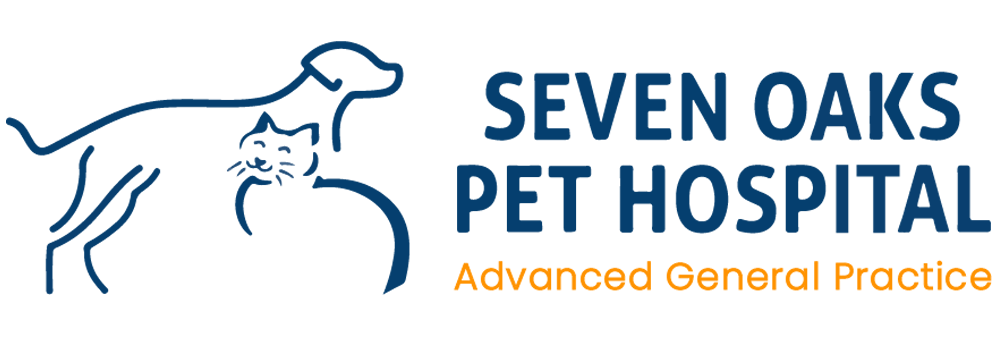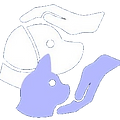Tibial Plateau Leveling Osteotomy (TPLO)
To download and print this information, please click here.
Tibial plateau leveling osteotomy (TPLO) is an increasingly popular method for treatment of anterior cruciate ligament injury in dogs.
Anterior Cruciate Ligament (ACL) ruptures, partial tears, chronic degenerative tears, and severe strains are extremely common in the dog. One sign that is easily apparent besides the dog being lame is that a dog with an injured ACL cannot sit straight. The ACL injuries affect all sizes, shapes, breeds, and ages. ACL Surgery is necessary to correct these injuries.
The cranial cruciate ligament (ACL) is one of the main stabilizing structures of the stifle joint ( knee joint). The ACL’s function in the dog is to prevent the femur bone from sliding backwards down the slope of the top of the tibial bone (Shin bone). TPLO surgery was invented by a brilliant veterinarian named Barclay Slocum. Dr. Slocum’s genius was in showing that if the top of the tibia is not sloped, the dog does not need an ACL. He was the first to describe the “anterior tibial thrust” which occurs every time the dog’s leg comes down. The tibia attempts to push forward, but is held in place by the normal ACL, just like a wagon is held on a hill by a rope. This instability results in lameness (limping) and osteoarthritis. Rather than reconstructing the ACL, which is ineffective, the goal of TPLO is to eliminate this instability by changing the biomechanics of the stifle joint.
The anatomy of the canine stifle joint is similar in many ways to the human knee joint. But, people don’t have an anterior tibial thrust. Our tibia has about a 6 degree angle to the “plateau” of the tibia. People need an ACL for all the diverse movements they do in sports. Dogs do not need an ACL if the top of the tibia is at 6 degrees. Dogs do not do the twisting that people do and don’t need the stability of the ACL in the same way that people do.
During this Surgery, the orthopedic surgeon performs an osteotomy (cut in the bone) on the tibia with a curved saw blade and rotates the fragment closest to the joint with relation to the rest of the tibia. The distance of this rotation is based on calculations the surgeon performs before the operation. The surgeon compresses the two resulting pieces of the bones and fixes the tibia in its new orientation with a plate and screws; both are made of surgical grade stainless steel. There are different kinds of bone plate and screws are used to repair. We use TPLO locking plate & Screws from Synthes (www.synthes.com).
TPLO is widely accepted to give the best functional outcome and has enabled working/performance animals to return to high functional standards. There is a trend to a slower progression of arthritis following TPLO surgery, versus dogs that received the MRIT (modified retinacular imbrications technique) however, arthritis usually will develop regardless of technique.
Post-operative risks associated with this operation and patients’ recovery include: delayed or abnormal healing, breaking and/or loosening of the plate and/or screws, and infection. To minimize the risk of complications while the tibia is healing, we recommend that TPLO patients be kept in a crate (cage) at all times until radiographs (X-ray images) are taken, usually at eight weeks after the operation. Bone healing may take up to 16 weeks in some patients. Rehabilitation exercises are performed at home during this recovery period and may be continued at the Animal Rehabilitation Center.
Slocum® Post-operative Care for Orthopedic Surgery
For eight to twelve weeks following surgery, a strict confinement regime is required with three important principles.
1. Your pet can be inside, on carpeted surfaces, under your direct supervision. It can wander around the room at a slow walk as long as it is not constant. Running, jumping, bounding, playing, etc., are not allowed.
2. Your pet must be on a leash at all times when outside for airing and going to the bathroom. If the animal has to cross slick floors or uneven ground, you need to use a “belly-band” in case it slips or stumbles. The “belly-band” is not used for support but rather as a safety net to protect your pet. Your pet is not allowed to be off lead when outside or to go for an actual walk.
3. When not under your direct supervision, your pet is to be confined in an airline kennel or equivalent.
General Information:
a. Playing with other animals is not allowed during confinement. If there are other pets in your household, you will need to keep them separated.
b. During confinement, your pet’s food intake needs to be reduced to help prevent weight gain. Most dogs will maintain their current weight if their food intake is cut in half. Water consumption should remain normal.
c. The first two weeks following surgery you will need to monitor your pet’s incisions. Licking or chewing can cause infection or sutures to loosen. If you notice that your pet has started licking, you will need to take steps to discourage it from doing so.
d. It takes a minimum of six to eight weeks for bones to heal.
e. One of the most difficult aspects of confinement is that the animals will frequently feel better long before they are healed. At this point your pet will start being more careless of the operated limb and is then more likely to be overactive and injure itself. Until the bone is healed, you must adhere strictly to the confinement guidelines and not allow your pet to do more.
f. If your pet is jumping or bouncing in its confined area, it is being too active. Tranquilizers may be required to help alleviate your pet’s anxiety or control its activity.
g. If at any time during your pets recovery and healing it does anything that causes it to cry out or give a sharp yelp, contact your veterinarian.
h. Following surgery your pet should always maintain at it’s current level of function, or improve. If at any time during your pet’s recovery and healing it has a set back or decrease in function, contact your veterinarian.
I. It is imperative that you inform your veterinarian at once if your pet does something that is potentially harmful to the surgery. If something has occurred which jeopardizes the outcome of surgery, it is usually less difficult to correct if it is caught right away, which leads to a better outcome for your pet.
j. If your pet is too active during it’s confinement it may injure itself or slow healing which increases the amount of time your pet must be confined.
k. Follow up appointments are usually needed two weeks post-operatively to monitor incisions and healing. At eight weeks post-operatively radiographs are taken at which time your pet is started on a regulated activity regime. A final appointment at four months post-operatively is needed for additional radiographs and final instructions before returning your pet to normal activity.
Slocum® Rehabilitation Regime:
- Once radiographs have confirmed bone healing, usually around eight weeks post-operatively, the rehabilitation regime is initiated.
- During this period the patient’s activities are gradually increased to build muscle, stretch scar tissue from surgery, and strengthen bone healing. The degree of activity should progress with your pet remaining comfortable. Since increasing duration, not intensity is the goal, explosive activities, such as running, jumping, or playing, are not allowed during the rehabilitation period.
- Throughout the rehabilitation process, the dog is allowed to go as far as it is able while remaining comfortable. To judge your pet’s comfort, watch the dog when it gets up following exercise and rest. If invigorated and excited about more activity, the animal is comfortable. If the dog gets up with stiffness and complaint, then the amount of activity should be reduced.
- The first three to four weeks of rehabilitation are comprised of progressively longer walks with the animal on a short lead, in the heel position. Begin with a five-minute walk, and see how the dog responds. If the dog does well, continue at this distance for three to four days. If your pet has remained comfortable during this time, double the distance of the walk. Monitor the dog’s comfort and after three to four days, double the distance of the walk again. Continue doubling the distance of the walk every few days as the dog’s comfort level permits. If the animal appears to be uncomfortable with the increased distance, cut the length of the walk back to the last distance at which it was comfortable; go for another few days at the lesser distance, then try doubling it again.
- Your pet will benefit more from several short walks in one day rather than a single long walk, so instead of doubling the length of a walk, you can double the number of walks. Rather than going from one 10 minute walk to one 20 minute walk, go for two 10 minute walks instead. Your pet will still be getting twice the activity, but it will be split up throughout the day. You can continue doubling the distance or number of walks as your schedule and your pet’s comfort allow. If your pet likes the water, you may substitute a swim for a walk at any time, allowing the swim for the same length of time as the walk you are replacing. Your dog should not, however, be allowed to launch itself into the water, but rather be encouraged to swim after it is already belly deep.
- During the fourth through the sixth week of rehabilitation, the walks are continued with your dog on a long lead, such as a 10-15 foot leash or a flexible lead. You will need to cut back the length of the walks you are currently going, as the long lead allows the dog the freedom to trot back and forth, increasing its usage of the leg. Usually, we recommend that you quarter the distance you are currently going on the short lead walks. Once you know where your pet’s comfort level is, you will double the amount of activity every few days. As distances are more difficult to judge at this point, it is important to monitor the dog’s comfort level closely during this stage of rehabilitation.
- During the seventh, through the ninth week of rehabilitation, your pet is allowed very mild activity off-lead. You will continue with the long lead walks and you will start letting your pet have time off lead in the yard, under your supervision. The area should have no other animals or distractions around. The off-lead activity should occur after your pet has had a walk to get some energy out of its system. Start with five minutes off-lead following a walk. As with the walks, double the time your pet is spending off lead in the yard every few days as long as your pet’s comfort level permits. The dog should remain under the voice control of the owner at all times. No jumping, chasing a ball, frisbee, or playing with other animals is permitted. Avoid any activities where the dog’s full concentration is thrown into the activity without regard for its body.
- A final checkup at the end of the rehabilitation process is needed before full activity may be resumed.



